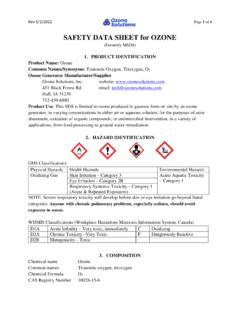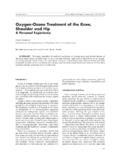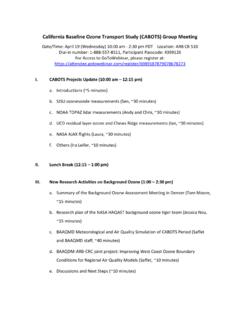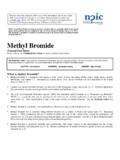Transcription of OZONE SPARGE TECHNOLOGY FOR …
1 1 OZONE SPARGE TECHNOLOGY FOR groundwater remediation Charles R. Plummer, , , Michael D. Luckett, , Shaun Porter, and Robert Moncrief ABSTRACT OZONE sparging is an oxidization remedial TECHNOLOGY for groundwater remediation , which is rapidly gaining wide acceptance by the State Agencies as an effective method for remediating groundwater impacted by volatile organic compounds (VOCs). In general, OZONE based processes for site remediation are similar to other chemical oxidation techniques in which the oxidant of choice is injected into the desired treatment area. However, the use of OZONE is different from most oxidation processes as the OZONE can be injected as a gas or liquid (as ozonated water). This approach provides the opportunity to deliver more continuous oxidation as opposed to batch applications typically associated with other techniques.
2 This discussion will focus on the basic application and design theory of the OZONE sparging process, agency acceptance of the TECHNOLOGY , and site applicability. An actual case study of one remedial project using OZONE TECHNOLOGY will be presented. The case study will cover site logistics, site geology, presentation of data before and during remedial activities, and conclusions on the effectiveness of the remedial action. The session will provide the attendee with a good overview of OZONE sparging TECHNOLOGY and its applicability to VOC remediation . INTRODUCTION Over the past few years there has been an emphasis by government agencies to develop new and innovative technologies for ground water remediation that are both efficient and cost effective.
3 One of these new technologies, in situ OZONE sparging, has emerged and is becoming a widely used technique. OZONE sparging involves injecting OZONE into the groundwater through a microporous oxidation point that is placed below the water table. The injected OZONE migrates outward and upward through the ground water. As the OZONE moves through the saturated region, chemical oxidation of the contaminants takes place. TECHNOLOGY OVERVIEW Chemical Oxidation OZONE (O3) is an allotrope of oxygen, consisting of three oxygen atoms that are less stable than diatomic oxygen (O2). OZONE is more soluble than oxygen in water and has been used for decades in municipal water treatment applications for disinfectant purposes. However, the use of OZONE as an in situ chemical oxidization (ISCO) compound for soil and groundwater remediation projects has increased over the last several years as an alternative remedial method.
4 There are 2 two distinct forms of in situ OZONE application: vadose zone injection of OZONE gas and OZONE sparging below the water table. In general, OZONE based processes for site remediation is similar to other chemical oxidation techniques in that the oxidant of choice is injected into the desired treatment area. However, the use of OZONE is different from most oxidation processes as the OZONE can be injected as a gas or liquid (as ozonated water). This approach provides the opportunity to deliver more continuous oxidation as opposed to batch applications typically associated with other techniques. OZONE is extremely effective in treating many groundwater pollutants, including: Benzene, toluene, ethylbenzene and xylenes (BTEX) Methyl tert-butyl ether (MTBE) Tert-Butyl Alcohol (TBA) Total Petroleum Hydrocarbons (TPH) Chlorinated solvents (ethenes and ethanes) Polychlorinated biphenyls (PCB) Perchloroethylene (PCE) Trichloroethylene (TCE) Phenols Chlorinated benzenes (CBs) Organic pesticides When an OZONE molecule comes in contact with a VOC molecule the OZONE reacts with the contaminant, producing innocuous substances such as carbon dioxide (CO2), water (H2O), and inorganic chloride, as shown in Figure 1, OZONE Oxidation of Hydrocarbons.
5 + 3 Figure 1: OZONE Oxidation of Hydrocarbons OZONE Production OZONE gas is formed when oxygen molecules (O2) are exposed to a controlled high-voltage electrical field. As oxygen molecules pass through this field, a portion of the molecules are split, creating a pair of O1 atoms. Seeking molecular stability, these atoms recombine with other O2 molecules in the air stream to form OZONE (O3), as shown in Figure 2, OZONE Production. Figure 2: OZONE Production OZONE SPARGE Equipment For soil and groundwater remediation applications, OZONE is delivered to the subsurface below the groundwater table via specialized equipment designed specifically for each site. An air compressor draws in ambient air, which is passed through an oxygen concentrator.
6 The oxygen concentrator removes nitrogen from the air stream, and delivers 90% pure oxygen to the OZONE generator after drying the air stream. The OZONE generator uses a high-voltage electrical current to convert oxygen to OZONE at 6% concentration by weight of OZONE . Another air compressor is then used to blend in ambient air with the produced OZONE , allowing the OZONE to be injected into the subsurface at typical flow rates of 1 to 4 cubic feet per minute (cfm) and up to 10 cfm at pressures up to 50 pounds per square inch (psi). The mixture of air and OZONE is injected into the groundwater aquifer through microporous oxidation points via a 10, 20, 30, or 40 oxidation port manifold at rates up to lbs/day at 1% concentration by weight of OZONE delivered to the subsurface.
7 A field programmable PLC-based controller with an interface panel viewer is used to control the manifold, allowing field personnel to enable and disable oxidation points, switch between OZONE and oxygen injection, set lag time between SPARGE cycles, and set SPARGE duration. It is imperative that all components on the OZONE side of the system are OZONE compatible. Compatible materials such as stainless steel, Teflon, Kynar, Viton, and schedule 80 PVC should always be used for OZONE applications. High-density polyethylene (HDPE) and natural rubbers should not be utilized with OZONE . Figure 3, OZONE SPARGE Equipment shows a cabinet and trailer-mounted OZONE SPARGE system that meets all the requirements described above. 4 Figure 3: OZONE SPARGE Equipment Advantages of OZONE SPARGE TECHNOLOGY Compared to other treatment methods, OZONE SPARGE TECHNOLOGY offers many important advantages when used for the remediation of contaminated groundwater : Minimizes the amount of waste materials produced.
8 Treatment is often accomplished in a shorter period of time. OZONE is generated on site, so storage and transportation of dangerous liquid chemicals is not required. Equipment is compact, minimizing site disruption. The by-product of oxidation with OZONE is oxygen, so no additional compounds are added to site chemistry. OZONE can be used to enhance other ISCO compounds, creating the conditions for Advanced Oxidation Process (AOP). DESIGN THEORY The four most critical design considerations for OZONE sparging are site-specific parameters that affect the OZONE dosage rate, the distribution of OZONE in the contaminated region, the reactivity of OZONE with the contaminants of concern, and regulatory requirements, which vary from agency to agency. 5 Site-Specific Considerations Oxidation is dependent on achieving adequate contact between oxidants and contaminants.
9 Failure to account for subsurface heterogeneities or preferential flow paths can result in extensive pockets of untreated contaminants. Each system is sized based on site-specific conditions. The systems are not one size fits all. The total treatment time is dependent on the site-specific goals and characteristics and should be sized accordingly. Site-specific characteristics that should be considered during the design of OZONE SPARGE systems, at a minimum, includes the following: Contaminants of concern (COC) Plume volume (determined from isoconcentration map) Contaminant mass Soil lithology or radius of influence data Hydrogeological data groundwater quality (inorganic and organic oxygen receptors) OZONE Distribution Considerations One of the most important aspects of any chemical oxidation program is providing adequate contact with the contaminants to be oxidized.
10 Typically, most applications deliver the oxidant throughout the area of impact in an effort to provide a greater amount of destruction. Injection points are strategically placed across the area of impact to provide over lap of the oxidant injections. Placement of each oxidation point is determined based on the radius of influence (ROI), which is dependent on the site lithology. For sandy sites the ROI can be as much as 40 feet, but is usually around 25 feet, and 10 feet or less in silty clay. The ROI can be determined for each site by conducting a typical air SPARGE pilot test using an air compressor and a few monitoring points. Figure 4, OZONE Distributions, illustrates a typical distribution of OZONE around an oxidation point.



![SAFETY DATA SHEET [formerly MSDS] 1 PRODUCT …](/cache/preview/b/8/1/9/4/d/b/f/thumb-b8194dbf3233d95ad71de2848134ba9c.jpg)



